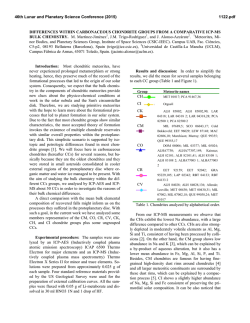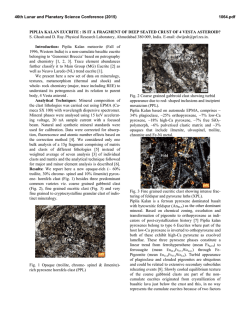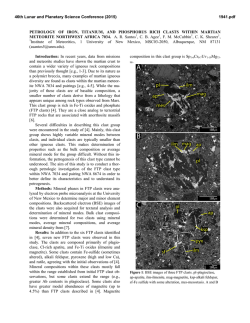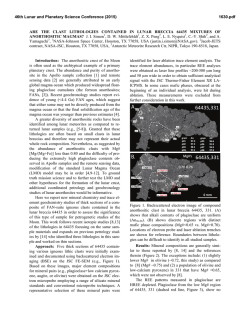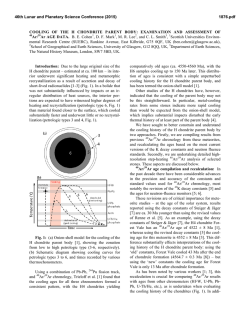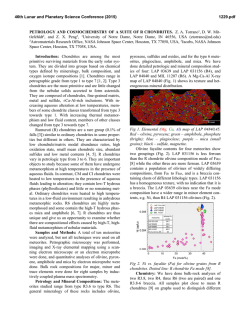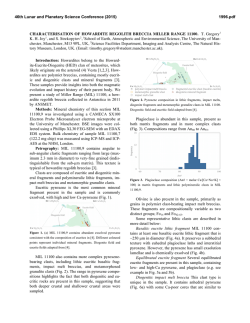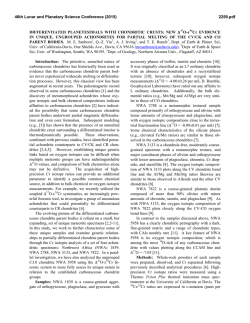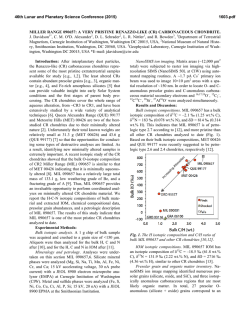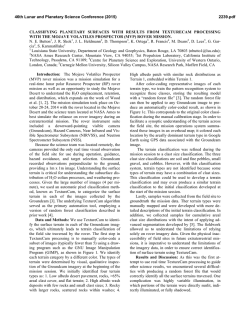
AN H CHONDRITE MELT CLAST IN AN LL CHONDRITE
46th Lunar and Planetary Science Conference (2015) 2678.pdf AN H CHONDRITE MELT CLAST IN AN LL CHONDRITE: EVIDENCE FOR MIXING OF ORDINARY CHONDRITE PARENT BODIES. C. M. Corrigan1, N. G. Lunning2, and K. Ziegler3. 1Smithsonian Institution, National Museum of Natural History, MRC 119, 10th and Constitution Ave. NW, Washington DC, 20560, USA. 2 University of Tennessee, Knoxville, TN 37996, USA. 3Institute of Meteoritics, University of New Mexico, Albuquerque, NM 17131, USA. E-mail: [email protected]. Introduction: In the course of studying impact melts in ordinary chondrites (OC) [1-4] we have identified a number of impact melt and other secondary clasts (i.e., not chondrules) within OC impact breccias. This is part of an ongoing search for ancient melt clasts to gain insight into the lunar cataclysm [5-10] and small body scattering in the early Solar System (causing the late heavy bombardment [11-13]). Potential melt clasts: Within the OC impact breccias involved in this study, a range of types of inclusions have been identified. Some are microporphyritic impact melt clasts (such as those found in LEW 85397, EET 87595 and PCA 02071 [3]). Others fall along a continuum of igneous textures ranging between quenched glasses and fully crystalline clasts. MET 01004 melt clast: In the brecciated Antarctic LL5 ordinary chondrite MET 01004 we found an extremely light colored clast (Fig. 1). The clast is approximately 3 x 4 cm on the exposed face of the meteorite. Thin sections were made of this clast and analyzed using instrumentation at the SmithsonianBackscattered electron imagery and elemental mapping were completed using the FEI NanoSEM at the Smithsonian, which is equipped with a THERMONORAN energy dispersive X-ray analytical system. Electron microprobe analyses were conducted using the Smithsonian’s JEOL 8900R Superprobe. Results: Optical microscopy and SEM imaging/mapping show that the clast is composed of olivine, pyroxene and plagioclase (Figs. 2, 3), some of which is poikilitically enclosing olivine. Very little metal (<1 vol.%) or sulfide are present in the clast (significantly less than the ~3-6% typical for LL chondrites [14,15]). Those metal grains that are present are coarse, as opposed to being disseminated throughout the clast. The clast is moderately shocked, with planar fractures and undulose extinction in olivine, pyroxene and plagioclase (which is not maskelynitized). The overall texture of the clast is achondritic, lacking any remnant chondrule features. Mineral chemistry/Bulk Composition: Olivines and pyroxenes were analyzed using the electron microprobe. Olivines have values of Fa19, and pyroxenes are Fs15. Compositions are within the H chondrite range [15], far from the LL chondrite host rock (Fa27.5-30 and Fs23.2-25.7). When compared with bulk LL chondrites [14], this clast is depleted in Fe and S and enriched in Si. The H chondrite silicate bulk composition [16] is similar to this clast (Table 1). Oxygen isotope composition: Oxygen isotope anal- yses were performed on 1-2 mg fragments of material using the laser-fluorination method of [17] at the University of New Mexico. Molecular O2 was extracted in cryogenically and gasa BrF5-atmosphere, chromatographically purified, and the isotope ratios measured on a gas source mass spectrometer (Delta PlusXL), with an analytical precision for Δ17O of 0.02 ‰. Results are, respectively, δ17O 2.640, 2.449, and 2.485; δ18O 3.691, 3.329, and 3.410; Δ17O 0.691, 0.691, and 0.691 ‰ (reference TFL slope = 0.528; values are all linearized). Results from these analyses place the MET 01004 clast at the low end of the H chondrite field (Fig 4), in agreement with the electron microprobe data. Discussion: Given this clast’s almost complete lack of metal and sulfides, its igneous texture, and its shock features, we believe that this is an impact melt clast that has been shock metamorphosed. Its oxygen isotope composition, mineral chemistry, and bulk composition are consistent with those of H chondrites, rather than with its host breccia (LL chondrite). The geologic history of this meteorite is an interesting one. Multiple possibilities for how an H chondrite impact melt clast was emplaced onto the LL chondrite parent body exist. One possibility is that impact melting of the H chondrite material occurred on its parent body and this material was then ejected and incorporated into the LL body. This event or subsequent impact shock may have then shocked the clast. Another possibility is that the H chondrite material melted as it struck the LL chondrite body (in which case it would have had to have cooled long before it was admixed into the LL parent body brecciated material). The clast found in MET 01004 shows several similarities to the melt clast found in the Peace River L6 chondrite [18]. The overall texture and mineralogy are similar, though, the Peace River clast contains less feldspar than that in the MET 01004 clast. Both clasts are depleted in metal relative to bulk ordinary chondrites. The Peace River clast formed from LL chondrite material, which was later, incorporated into an L chondrite (Peace River). Previously reported lithic clasts (potentially impact melts) may be additional evidence of mixing between ordinary chondrite groups. An igneous textured clast in Chantonnay (L6) has bulk composition consistent with H chondrites [19]. Lithic clasts in the L6 chondrites Y75097 and Y-793241 have H chondrite oxygen isotope compositions, but the major element chemistry of these clasts has thermally equilibriated with the host L6 ma- 46th Lunar and Planetary Science Conference (2015) 2678.pdf terial [20]. In any case, the impact melt clasts in MET 01004 and Peace River provide evidence for impact melting and mixing between ordinary chondrite groups. Age dating: Impact melt clasts from OCs are distinctly under-represented in terms of solar system ages [15], but if successfully obtained, these dates will lead to a better understanding of how early solar system bombardment affected the asteroid belt. We certainly recognize that this is a significant challenge. Age dating of the H chondrite clast and other clasts in MET 01004 will help us further understand mixing between ordinary chondrite parent bodies. Figure 3: BSE image of olivine chadacrysts poikilitically enclosed by pyroxene and plagioclase. Field of view is 5 mm (horizontally). References: [1] Corrigan & Lunning 2013 MAPS 48, #5256 [2] Corrigan et al., 2012, LPSC 43 #1577 [3] Corrigan and Lunning 2012, MAPS 47, #5320 [4] Corrigan & Lunning, 2013, LPSC 44 #2615 [5] Turner et al. 1973, 4th LPSC, 1889 [6] Tera et al. 1974, EPSL 1, 19 [7] Kring & Cohen 2001 JGR 107, doi: 10.1029/2001JE001529. [8] Cohen et al. 2005, MAPS 40, 755 [9] Ryder et al. 2002, JGR 107, 6-1 [10] Hartmann 2003, MAPS 38, 579 [11] Tsiganis et al. 2005, Nature 435, 459 [12] Morbidelli et al. 2005, Nature 435, 462 [13] Gomes et al. 2005, Nature 435, 466 [14] Jarosewich, 1990, Mets 2, 323 [15] Gomes & Keil, 1980, Brazilian Stone Meteorites, U of NM, ABQ [16] Mason, B. (1965) Amer Mus Novitates 2223, 1-38 [17] Sharp (1995) Am J Sci 295, 10581076. [18] Herd et al. 2013 Canad J Earth Sci 50, 14 [19] Yolcubal et al. (1997) JGR 102, 589 [20] Nakamura et al. (1994) Proc. NIPR Ant. Met. 7, 125 Figure 4: Oxygen isotope composition of igneous textured melt clast from MET 01004. Filled (red) circles correspond to the melt clast discussed in this abstract. Figure 1: Photograph of igneous textured melt clast in LL breccia MET 01004. The large, light-colored clast (~3 x 4 cm) is the subject of this abstract. Table 1: Bulk composition of the igneous clast from MET 01004 compared to ordinary chondrites. Figure 2: XPL image of olivine chadacrysts poikilitically enclosed by pyroxene and plagioclase. Wt. % Ratios MET 01004 Igneous Clast Bulk LL Chondrite [14] H Chondrite Silicates [16] Fe/Si 0.54 0.94 0.44 Fe/Mg 0.64 1.2 0.52 Fe/Mn 34 58 38.6 S/Mg 0.01 0.12 N/A Si/Mg 1.2 0.92 1.2
© Copyright 2026
